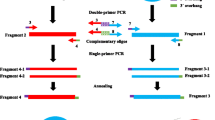Abstract
This article describes a simple and rapid method for efficient production of chimeric products by polymerase chain reaction (PCR). This protocol is amenable to site-directed mutagenesis strategies and can be done without the time-consuming gel purification step. The PCR products generated can also be directly used for direct gene transfer into plant cells without further subcloning to test construction strategies.
Similar content being viewed by others
References
Higuchi, R. (1990) Recombinant PCR, inPCR Protocols: A Guide to Methods and Applications (Innes, M. A., Gelfand, D. H., Sninsky, J. J., and White, T. J., eds.), Academic, San Diego, CA, pp. 177–183.
Horton, M. R., Cai, Z., Ho, S. N., and Pease, L. R. (1990) Gene splicing by overlap extension: tailormade genes using the polymerase chain reaction.Bio Techniques 8, 528–535.
Pont-Kingdon, G. (1994) Construction of chimeric molecules by a two-step recombinant PCR method.Bio Techniques 16, 1010–1011.
Lefebvre, B., Formstecher, P., and Lefebvre, P. (1995) Improvement of the gene splicing overlap (SOE) method.Bio Techniques 19, 186,187.
Brandt, A., Montembault, A., Cameron-Mills, V., and Rasmussen, S. K. (1985) Primary structure of a B1 hordein gene from barley.Carlsberg Res. Commun. 50, 333–345.
McElroy, D., Chamberlain, D. A., Moon, E., and Wilson, K. J. (1995) Development ofgusA reporter gene constructs for cereal transformation: availability of plant transformation vectors from the CAMBIA Molecular Genetic Resource Service.Mol. Breeding 1, 27–37.
Farrell, L. B. and Beachy, R. N. (1990) Manipulation of β-glucuronidase for use as a reporter in vacuolar targeting studies.Plant Mol. Biol. 15, 821–825.
Murashige, T. and Skoog, F. (1962) A revised medium for rapid growth and bioassays with tobacco tissue cultures.Physiol. Plant 15, 473–497.
Lemaux, P. G., Cho, M.-J., Louwerse, J., Williams, R., and Wan, Y. (1996) Bombardment-mediated transformation methods for barley. Bio-Rad US/EG Bulletin2007, 1–6.
Jefferson, R. A., Kavanagh, T. A., and Bevan, M. W. (1987) GUS fusions: β-glucuronidase as a sensitive and versatile gene fusion marker in higher plants.EMBO J. 6, 3901–3907.
Author information
Authors and Affiliations
Corresponding author
Additional information
An erratum to this article is available at http://dx.doi.org/10.1007/BF02752269.
Rights and permissions
About this article
Cite this article
Cho, MJ., Lemaux, P.G. Rapid PCR amplification of chimeric products and its direct application to in vitro testing of recombinant DNA construction strategies. Mol Biotechnol 8, 13–16 (1997). https://doi.org/10.1007/BF02762336
Issue Date:
DOI: https://doi.org/10.1007/BF02762336




